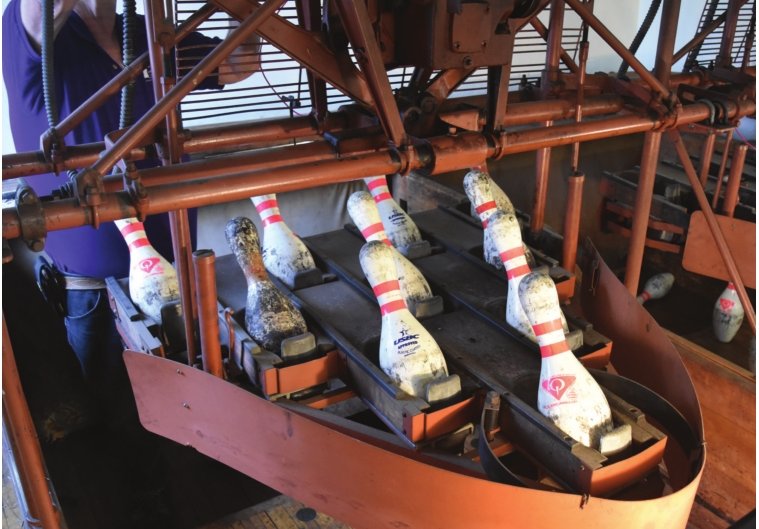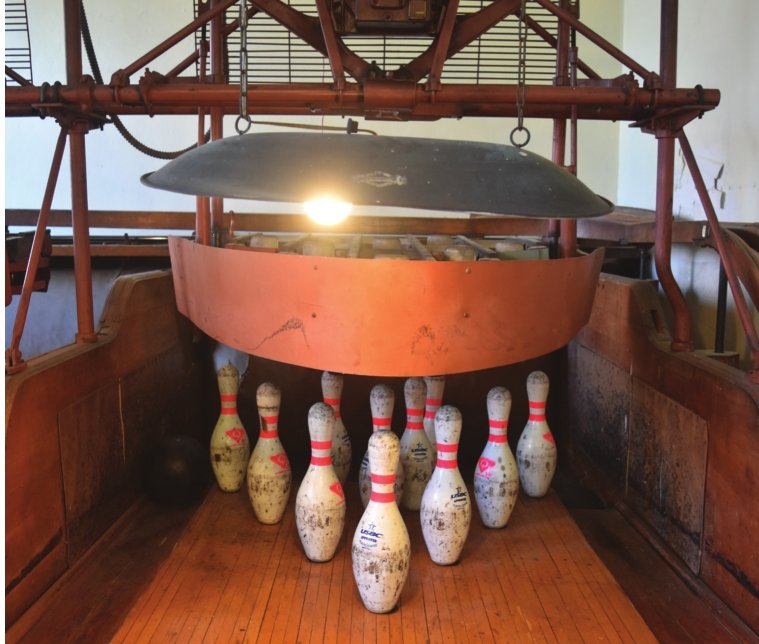
The history of the rare ‘20s-era Brunswick bowling alley tucked inside Central United Methodist Church is written on its scarred pins. Generations of bowlers threw archaic rubber bowling balls down its lanes; some pins have a Dalmatian pattern and some look almost completely black with wear.
Housed above the church’s basketball court, the two-lane bowling alley sports original Brunswick manual pinsetters, wooden ball gutters and a wooden ball return, which relies solely on momentum. It also has Brunswick spectator seats and original bowling lighting shrouds.
Manual pin setting was no easy task.
People on pin setting duty would have to wait until the players bowled, then the pin setter would jump in the pit, set the pins in the machine, switch it down and send the bowling ball off on the track back to the players.
“Probably after eight times hopping over there picking up pins, you would probably be tired of doing it,” said Bruce Newton, Central Methodist United Church’s facilities manager.
Custodian attendant Jack Neller said Brunswick stopped by in the early 2000s to take a look at the machines after someone called from the church requesting a shaft be replaced.
“They called Brunswick and they were just shocked,” Neller said. “Brunswick didn’t know the machines were there and told us those machines aren’t even in existence anymore.”
According to Neller, Brunswick came down to the church and offered to take everything out and put it in a museum, but the church refused.
“It’s nice to keep those things around, but the problem is that they need upkeep too,” Neller said. “The lanes need a lot of work done to them.”
Installing the bowling alley was part of the effort to build a community center in Lansing, Newton said.
“In the ‘20s, there was a lot happening.

There wasn’t a lot of room for anything, and there wasn’t a central meeting place, even though it was next to the state capital.”
R.E. Olds executive Richard Scott and his wife Gertrude Scott provided the money to solve this problem. Their donated 1923 addition would be known as the Temple House, which included a basketball gym, locker rooms, bowling alley, offices, an auditorium and a kitchen.
“It didn’t matter what your faith was or belief was. You could come here and there would be a place for you,” Newton said.
The church doesn’t use the bowling alley often, but once in awhile Newton allows groomsmen waiting for a wedding to bowl a few frames.
The last renovation work done to the alley was a youth group that painted the walls. If the bowling alley were to fall into regular use again, it would take serious work.
“The ceiling needs a lot of work, the lighting needs some work and the bowling lanes themselves need to be sanded and resealed,” Newtown said.
Having the bowling alley functional again would be a real benefit to the church.
“Whether you can get a league to do a manual pin set alley, I don’t know.”
Correction:
Due to reporting and typographical errors in the Sept. 12 issue, Central United Methodist Church was referred to as a brick building instead of stone and Mayor Andy Schor’s name was misspelled “Shor.”
Support City Pulse - Donate Today!
Comments
No comments on this item Please log in to comment by clicking here